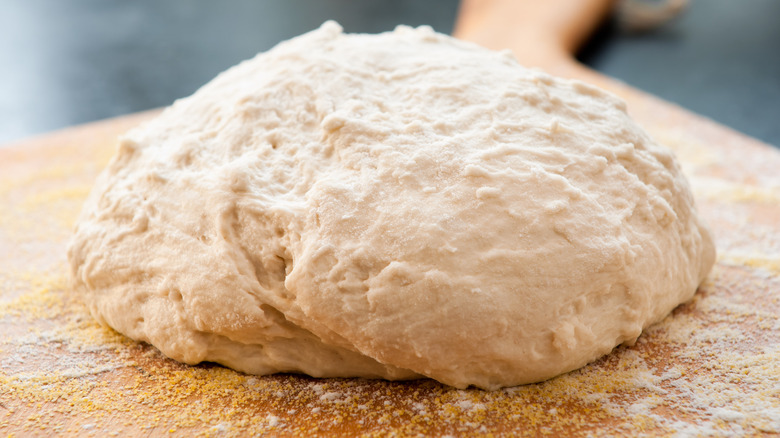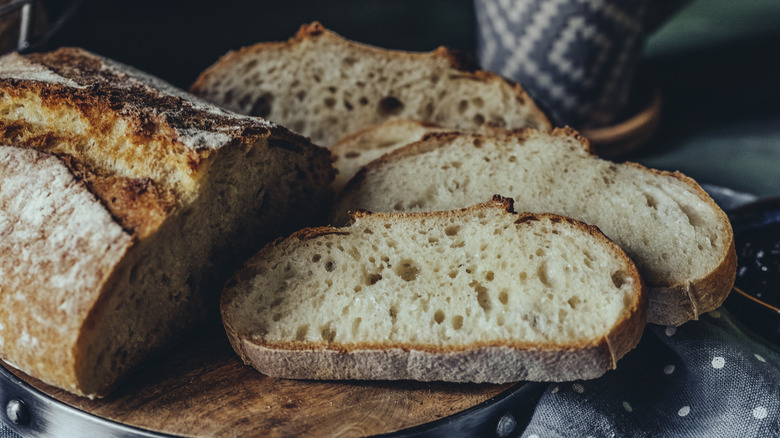The Secret To Julia Child's Go-To Sandwich Bread
Bread has been a culinary canvas for many chefs, including the inventive and inspirational Julia Child. Her remarkable recipes feature an array of helpful hints that elevate the ordinary to the extraordinary. Child, a gregarious gastronomist of everything gourmet, spent years in the kitchen and shaped many carefully crafted dishes for the culinary world. Julia Child's hack for creating superb scrambled eggs and other touted and tasty concoctions puts her in the canon of master chefs.
Many cream-of-the-crop chefs who make it to the top of the class have learned the art of baking bread. Child built a repertoire of skills in transforming tough dough into the softest slices of bread that spotlight her French training and rustic rural life. She tackled brioche, quick breads, sourdough, pumpernickel, buttermilk white, and more on her beloved and seasons-long show, "The French Chef." However, according to Food & Wine, Julia Child has a secret that sets her sandwich bread recipe apart from the pack. She suggests using a preferment mixture of flour, water, and yeast to enhance the bread's flavor.
This skillful take on sandwich bread speaks to Child's risk-taking yet tactful and technical style. This bread reminds her fans of her culinary talent, and this secret will likely lead them to say one of her favorite phrases, "Bon Appétit!"
Practice the process for a perfect preferment
Julia Child performed a preliminary step to produce her signature sandwich bread. The secret for Child's savory bread is the preferment, a modified portion of starter dough made of flour, water, and active dry yeast. This simple yet effective step involves preparing this smaller piece of mixed dough ahead of a bigger portion during the baking process.
Bakers allow bread dough to ferment through yeast, which is essential for beginner bakers. The yeast changes the sugars and starches to carbon dioxide over a specific period of time, ranging from several hours to years. The length of fermentation time depends on the type of preferment, and whether it has commercial or naturally occurring yeast. Preferments using manufactured yeast, such as the French pâte fermentée or the Italian biga, typically ferment for eight to 16 hours. Wild or natural yeast-based preferments, such as levain or sourdough, can last for a week or longer.
If you're making Child's sandwich bread recipe, you can find active dry yeast — a convenient choice for commercial bakers — at your local grocery store. After whisking the yeast with flour and water, wrap the dough and allow it to ripen at room temperature for several hours or overnight.
Preferment helps to marry taste and texture
The preferment is a useful and worthwhile addition to Julia Child's sandwich bread recipe for several reasons, including strong flavor. The finished product will have a slightly sweet wheat taste that's pleasing and inviting. Aromatics also play a role, as the bread may take on a more pleasant smell that flows through the kitchen and excites you like your favorite quick breads.
Bakers who use a preferment also benefit from a better texture for the bread. The yeast, known as a leavening agent, is responsible for the rising of the dough. Of course, risen dough is more presentable and makes for a hearty and filling loaf. Also, the yeast works with the gluten to create a tougher dough. Bakers end up with bread with more weight given the composition, yet it avoids a dense heaviness.
This sandwich bread will also last longer, thanks to the preferment. The acidity that forms during the fermentation process will lend a longevity quality to the bread that's similar to levain and sourdough, which have long shelf lives as well. It is also important to note that bread with a higher acidity (and thus a loaf that can keep for a while) has a lower pH, which is a point of consideration when making a preferment. Whether you're making Julia Child's sandwich bread or a loaf of sourdough, preparing a preferment beforehand can help you achieve your preferred results.


